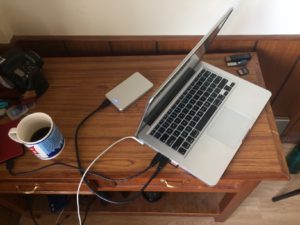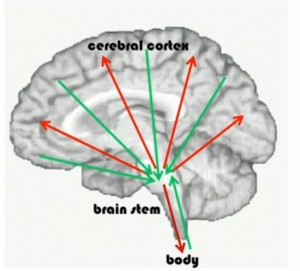My most recent blog posts have been devoted to technology adoption and use from the 10,000 foot level. My investigation is making me aware of the research on adoption from the perspective of business, education, and the individual; considered by age, confidence, background, socio-economic status, interests, affiliations and need. Suffice it to say, I have a lot to learn about this research; the conclusions people have made as well as unanswered questions related to adoption.
In this post I present some practical, tangible, and personal practices that support technology adoption and competence. I offer some insights for managing your personal approach to technology.
My Tools
Managing technology has been a professional and personal evolution for me. My personal evolution began in 1987 with an introduction to computers in graduate school. My initial fascination with them grew from writing, spreadsheets and general organization to networking, email and file sharing. I quickly learned that my fascination was not shared by others and that my curiosity marked me as the go to guy when someone needed support. Clearly this was not due to my superior knowledge – I had very little. It was more a question of my willingness and persistence. I valued the resource and had a sense that it would pay off over time.
Institutional Adoption
Fast forward ten years – I found myself working in an advisory capacity to the technology director for the Roaring Fork School District. 5 years later I was hired as the director. My years with the department and as technology director put me in the position of leading software implementations (not to mention software development). I had the opportunity and sometimes dubious task of convincing people that new applications would be useful and worth the time required to learn them. My first assignment was to implement a new phone system across our 11 school sites. Within this project and others, there were a variety of considerations, complications and forces at work. I will delve into these at some other time. Suffice it to say that mistakes were made, and with each project, I learned a lot. One key lesson was that compulsory adoption can put people in a defensive position and create resistance even when skill is not an issue.
Not withstanding the missteps we made in promoting / supporting some computer applications in the school district, I sincerely believe that there is great value in computer applications for institutions and individuals. This belief drives my curiosity to help people through their own adoption process; beyond personal resistance and/or technical confusion. Helping people adopt a new technology or make better use of something they are vaguely familiar with allows me to extend my personal quest with tech tools. Thank goodness I’m no longer expected to make large numbers of people adopt applications without their expressed consent. Now I can work with the willing. Even when knowledge and skill are lacking, consent is a powerful force.
Helping People Choose
I enjoy helping people use technology – they choose; technology that can help them communicate, be creative and informed or that allows them to automate or streamline a task. By virtue of asking for my help, my clients are a step ahead of my former captive audience. They have already made a commitment on some level. They have chosen a particular computer, application and/or goal. They may not be happy with tools they are working with. But they are motivated on some level.
Once a commitment is made, it is important that support and methods are available to overcome inevitable barriers. It’s technology after all! While we can picture the solution working, it doesn’t often work the first time. First there are barriers of time, skill, confusing menus, unfamiliar concepts, and a host of other technical issues. Though the technical barriers can be substantial, the proper frame of mind can help us persist through the learning process. The way we think about our tools, our confidence and learning strategies are essential to our success. A positive attitude, the right environment, adequate focus and self talk strategies come in handy. When I talk about “tools4mind”, I am referring to the software of our brain as much as the hard digital tools. The mind is a much overlooked tool.
Attitude Counts
While we may not consider our frame of mind as important to our success, there is mounting research that lends credence to it. A series of studies were conducted in the 60s and 70s by Walter Mischel at Stanford University. His longitudinal study found that children who were able to delay gratification showed greater competence / success later in life. Evidence in a 1988 followup study of these children showed:
“Delay of gratification, assessed in a series of experiments when the subjects were in preschool, was related to parental personality ratings obtained a decade later for 95 of these children in adolescence.… Specifically, children who were able to wait longer at age 4 or 5 became adolescents whose parents rated them as more academically and socially competent, verbally fluent, rational, attentive, planful, and able to deal well with frustration and stress.”
In 1990, other follow up studies of these children showed that the the children who waited scored higher on SAT tests.
The original “cookie” study has been replicated and refined. Results have suggested while these traits are pervasive over time, there are environmental factors that mediate the delay of gratification. In other words, if we fail the marshmallow test at 5 years old, we aren’t destined to be an under-achiever. One such study found that previous experience matters:
Children who experienced reliable interactions immediately before the marshmallow task waited on average four times longer—12 versus three minutes—than youngsters in similar but unreliable situations.
Changing the environment by making it more unreliable or reliable had dramatic effects:
“…Children who experienced unreliable interactions with an experimenter waited for a mean time of three minutes and two seconds on the subsequent marshmallow task, while youngsters who experienced reliable interactions held out for 12 minutes and two seconds
…provides strong evidence that children’s wait times reflect rational decision making about the probability of reward.
…If you are used to getting things taken away from you, not waiting is the rational choice.”
Nature or Nurture
What are the implications of this study for computer users like you and me? My observations (of myself and others) lead me to believe that persistence is one of the keys to learning technology. In my role as technology director, I supervised 6 technicians of varying technical ability and background. The most common characteristic of the 6 was their desire and focus. While their persistence wasn’t uniform or consistent across all domains, it was evident most of the time. Constantly faced with novel problems, they would hunker down and, through repeated iterations of testing, uncover the secrets of problems and applications. While I didn’t always grasp the content of the problem they were solving, I clearly followed their process. They were pit bulls on the pant leg of technology.
Were my staff born with the ability to focus and persist through digital problems? Or did they develop strategies over time that facilitated their success? Perhaps it was a little of both. Perhaps they were born into secure environments where they trusted that waiting would yield greater satisfaction. Perhaps they were born with brains that favored planning over impulse. My guess is that it was both.
As an adult I have one choice; to find ways to adapt and improve my innate abilities. There is no going back. Brain surgeons and the pharmaceutical companies cannot help me change my brain. Learning to learn, sharpening our brains can make a difference. It is a process of discovery, of practice, and progress. Stay tuned for more.

 That grey box that you see connected to the computer is now the brains of the computer. Using the hard drive delivered from the US and some random flash drives that I brought with me, I spent the week diagnosing and fashioning a system that works. It is pretty or convenient but it works.
That grey box that you see connected to the computer is now the brains of the computer. Using the hard drive delivered from the US and some random flash drives that I brought with me, I spent the week diagnosing and fashioning a system that works. It is pretty or convenient but it works.





